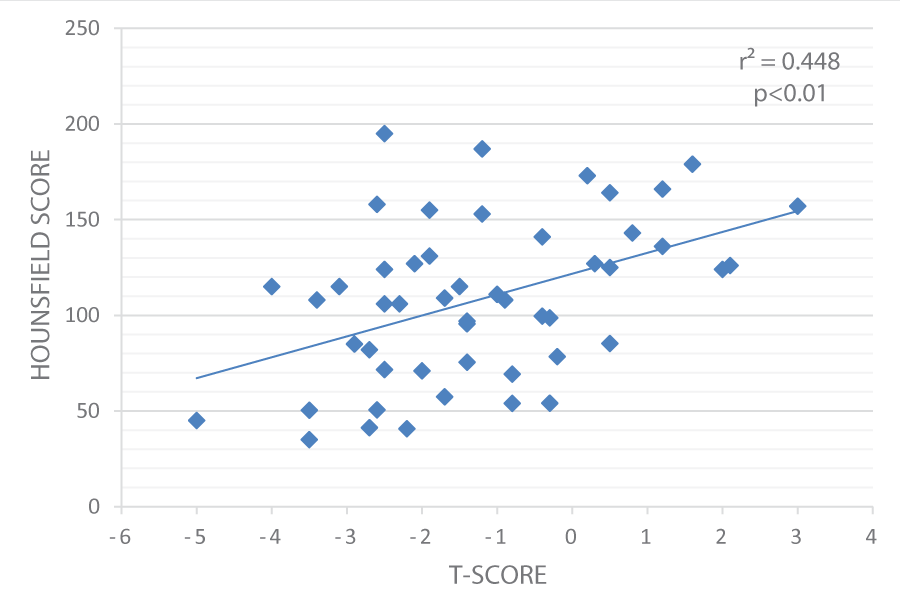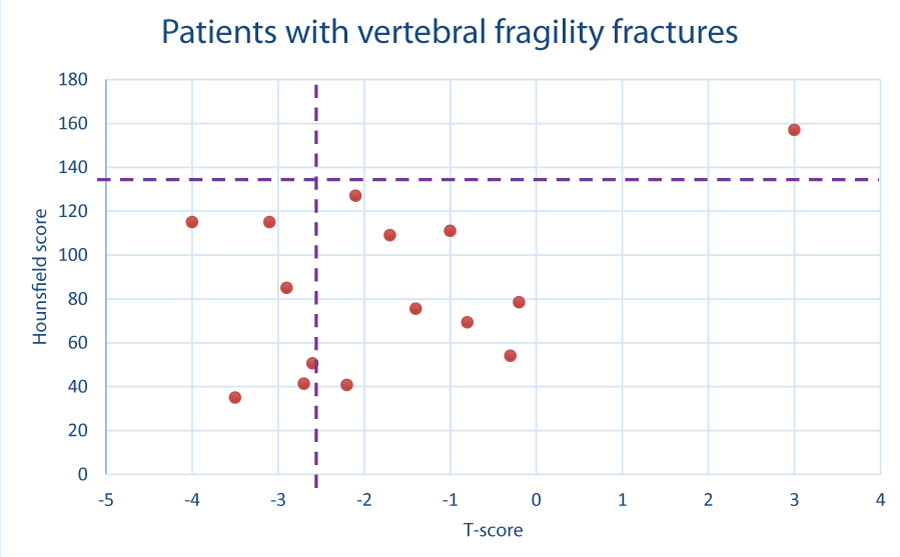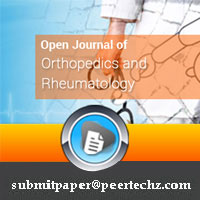Open Journal of Orthopedics and Rheumatology
A Concordance study of CT densitometry with DXA densitometry
Ruwani Mawella* and R Rajak
Cite this as
Mawella R, Rajak R (2022) A Concordance study of CT densitometry with DXA densitometry. Open J Orthop Rheumatol 7(1): 001-003. DOI: 10.17352/ojor.000042Copyright License
© 2022 Mawella R, et al. This is an open-access article distributed under the terms of the Creative Commons Attribution License, which permits unrestricted use, distribution, and reproduction in any medium, provided the original author and source are credited.Introduction
Osteoporosis is a skeletal disorder characterized by compromised bone strength resulting in an increased risk of fracture [1]. Bone Mineral Density (BMD) is responsible for 60-90% of the strength of bone [1] and the current standard of assessment is by Dual-energy X-Ray Absorptiometry (DXA). DXA generates T-scores of the lumbar spine, femoral neck, or hip by calculating the difference between the individual’s BMD and the population mean, divided by the standard deviation of the reference population. The World Health Organisation (WHO) classifies osteoporosis at a T-score of or below -2.5.
Although DXA is the only technology that can be used for the diagnostic classification of osteoporosis according to WHO, Computed Tomography imaging (CT) densitometry of the spine has equal or superior ability to predict vertebral fractures in postmenopausal women [2].
A method of estimating bone mineral density from CT images was introduced in 2013 in which a circular region of interest (ROI) was placed on a single axial CT image in the anterior trabecular portion of the L1 vertebral body (avoiding the venous plexus) to quantify CT attenuation in Hounsfield units as a surrogate for bone density [3]. Hounsfield unit values are a measurement of the standardized linear attenuation coefficient of tissue, based on a defined scale of 0 for water and -1000 for air [4]. L1 was selected as it is relatively spared from degenerative changes that affect the lower lumbar spine and is commonly included at both chest and abdominal CT examinations [4].
DXA includes the posterior elements of the spine and therefore may be inaccurate in cases where the patient has severe spinal degeneration, scoliosis, or following lumbar surgery [5]. Contamination by intra and extra-osseous soft tissue absorption of X-Ray may also contribute to inaccuracies in the DXA output values of BMD [6]. Computed tomography techniques, however, can be limited to specific regions of interest, such as the vertebral body trabeculae, which have been shown to be most predictive of fracture [5]. Therefore the continued use of DXA as the primary modality of calculating BMD may lead to inaccurate exclusion of osteoporosis and prognostication.
Aims and objectives
Our study aims to assess the concordance of spinal CT densitometry with the current standard of assessment through DXA-derived densitometry.
Methods
The cohort of our retrospective study was identified by searching for patients attending the osteoporosis clinic who had had both a DXA scan of the lumbar spine and CT lumbar spine/thorax/abdomen performed within 18 months of each other. We identified 51 records in this cohort, between July 2018 – August 2021, which included 11 men and 40 women. One record was excluded as there was too much degeneration within the vertebral bodies to calculate an accurate Hounsfield score.
The CT images were analyzed by the same physician to attain a mean Hounsfield score using a circular ROI within a sagittal section of a single vertebral body (T12-L4) measuring trabecular bone density. The ROIs were made as large as possible while avoiding cortical bone surfaces and areas of degeneration.
Hounsfield units are the measurement of radiodensity used in the interpretation of CT images. A study by S. Vadera, et al. found that a Hounsfield score below 131 showed a balanced sensitivity and specificity for diagnosing osteoporosis akin to a DXA-derived T score of -2.5 or less [7].
The final data collected was analyzed to find correlation values of Hounsfield score with T-score using Pearson correlation coefficient.
Results
The mean age of the 50 patients in our study was 75 years with a range of 26-92 years.
Hounsfield scores ranged from 35 to 195 and DXA-derived T-scores ranged from -5.0 to +3.0.
The mean Hounsfield score was 108.4 (osteoporotic BMD) compared to a mean T-score of -1.22 (osteopenic BMD) with a statistically significant correlation coefficient of 0.447, (p<0.01) (Figure 1).
Using the WHO classification of T score ≤-2.5, 15 of the patients included in our study (30%) would have a diagnosis of osteoporosis whereas this would be 36 patients (72%) if using the threshold of Hounsfield score <131.
Bone density as shown by the mean Hounsfield score was observed to decrease with age although the same trend was not seen with mean T-scores (Table 1).
Out of the 50 patients included, 15 had vertebral fragility fractures (Figure 2). The mean T-score for these patients was -1.2 (osteopenic BMD) and the mean Hounsfield score was 108 (osteoporotic BMD).
Discussion
Our study showed a moderate positive correlation between the DXA-derived T-scores and CT Hounsfield scores. This further validates previous studies that suggest CT scans can be used to identify patients with osteoporosis.
The mean Hounsfield score indicates a lower bone density than the mean T-score identified. Also, the CT Hounsfield scores had higher diagnostic accuracy in osteoporotic patients with fragility fractures; 93% of patients with vertebral fragility fractures were identified as having osteoporosis using CT densitometry whereas only 40% were identified via DXA. These findings highlight the limitations of DXA, particularly in terms of the overestimation of bone mineral density related to degenerative changes. These findings also support previous study findings of superior ability to predict vertebral fractures with CT [2] likely because it can be limited to the specific regions of interest, the vertebral body trabeculae [5]. Overall, our study supports the use of CT densitometry as an accurate measure of low bone density and a better predictor of future risk of fractures than DXA.
CT imaging is performed for numerous indications. CT images of the thorax, abdomen, or lumbar spine that have already been performed for other indications can be used to opportunistically screen for osteoporosis without additional radiation exposure, waiting time, or cost. This may allow for earlier diagnosis, treatment, and fracture risk reduction.
- Bartl R, Bartl C (2019) The Osteoporosis manual; Prevention, Diagnosis and Management. Germany: Springer International Publishing. Link: https://bit.ly/3JLFBZK
- Engelke K, Adams J, Armbrecht G, Augat P, Bogado C, et al. (2008) Clinical Use of Quantitative Computed Tomography and Peripheral Quantitative Computed Tomography in the Management of Osteoporosis in Adults: The 2007 ISCD Official Positions. J Clin Densitom 11: 123-162. Link: https://bit.ly/3v9azHq
- Pickhardt P, Pooler B, Lauder T, del Rio A, Bruce R, et al. (2013) Opportunistic Screening for Osteoporosis Using Abdominal Computed Tomography Scans Obtained for Other Indications. Ann Intern Med 158: 588–595. Link: https://bit.ly/3JGMED6
- Schreiber J, Anderson P, Hsu W (2014) Use of computed tomography for assessing bone mineral density. Neurosurg Focus 37: E4. Link: https://bit.ly/3BHXqX6
- Eswaran S, Gupta A, Adams M, Keaveny TM (2005) Cortical and Trabecular Load Sharing in the Human Vertebral Body. J Bone Miner Res 21: 307-314. Link: https://bit.ly/3HmrR6p
- Bolotin HH (2007) DXA in vivo BMD methodology: an erroneous and misleading research and clinical gauge of bone mineral status, bone fragility, and bone remodelling. Bone 41: 138-154. Link: https://bit.ly/3JJ7Msj
- Vadera S, Osborne T, Shah V, Stephenson J (2020) Opportunistic screening for osteoporosis by abdominal CT in a British population. Clin Radiol 75: e2-e3. Link: https://bit.ly/33FEQSP
Article Alerts
Subscribe to our articles alerts and stay tuned.
 This work is licensed under a Creative Commons Attribution 4.0 International License.
This work is licensed under a Creative Commons Attribution 4.0 International License.



 Save to Mendeley
Save to Mendeley
